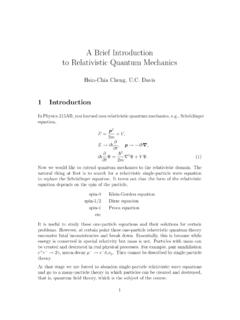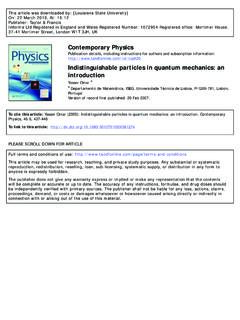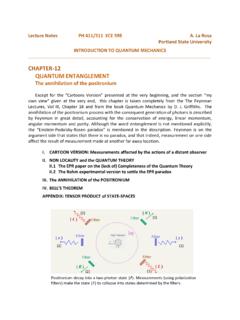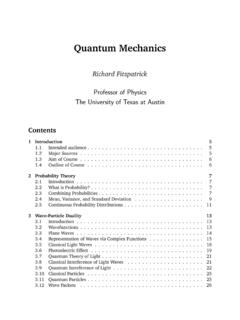Transcription of Introduction to quantum mechanics Introductory …
1 1I. SYLLABUS AND INTRODUCTIONLet us start with a brief overview of the items that will (hopefully) becovered in this course and to give a guidelineof what we are trying to mechanics 660 and 661 are advanced quantum mechanics courses designed for graduate students. Thecourses will be treated as a one-year course. It will be assumed that students have already some background inquantum mechanics (the concepts of waves, quantization, expectation values, etc.). An advised Introductory text-book isIntroduction to quantum mechanicsby Griffiths. A number of things will, however, be repeated albeit in amore mathematical fashion.
2 Also some basic knowledge in Fourier analysis, differential equations and linear algebra(calculation of eigenvalues and eigenstates) will be expected. All the information you need to know are in the lecturenotes. However, the lecture notes are relatively concise and further reading is recommended. The book that wasused last year was Liboff, Introductory quantum mechanics , fourth edition. However, a lot of other books treat thematerial of 660 in a similar fashion, so pick a book that you like best. Some of the material is not covered in Liboff(the older editions don t have relativistic quantum mechanics and quite a bit of the material of 661 is not in there).
3 The course is developed from a physicists point of view. Some concepts and mathematical techniques will be intro-duced along the way (such as matrix techniques) under the assumption that most of you are already somewhat familiarwith them (after all, there are also 3 and 4 hundred level quantum mechanics courses). For a more comprehensiveview of those things, I will refer to the textbook. The subjects that will be covered are History, Planck s quantum hypothesis, photoelectric effect,specific heat,atomic Introduction is somewhat different from what is usually given in textbooks.
4 However, since most of youhave already followed a quantum mechanics course and since this is a graduate course, I think it is interesting todo it this way. Quite some time will be devoted to Planck s hypothesis. The physical language is quite differentfrom that of the rest of the course (it is more thermodynamics than quantum mechanics ). Some of these thingsare treated in the exercizes of Chapter 2 of Liboff. Other things willbe mentioned more briefly. Wave mechanics , Schr odinger equation, probability density, free particles, Heisenberg s uncertainty section tries to show some of the thinking that led to the Schr odinger equation.
5 As soon as you leave theidea of a particle as a billiard ball behind you, a number of other things follow directly, such as Heisenberg suncertainty principle. Harmonic oscillator, Schr odinger equation approach, Solution using operators, Operators and wavefunctions,Correspondence most of you have seen the harmonic oscillator already, it is an important example, since the numberof exactly solvable models in quantum mechanics is limited. Try to pay special attention to the two approachesto attack this problem. The Schr odinger approach, solving the differential equation for the wavefunction, andthe algebraic or operator approach due to Heisenberg, Jordan, and Born.
6 Although the Schr odinger approachis more intuitive, the operator approach will become more importantas we go on, since often we do not reallycare that much about the wavefunction, but we are more interested in the spectral properties (energies) Of theproblem. The Hydrogen atom, Legendre polynomials, angular momentum, matrix pay attention to the dual approach to this problem. The Schr odinger approach (solving the wavefunction)and the operator approach (angular momentum). This involves quite a bit of mathematics (solving differentialequations). Here we will only deal with the potential from the nucleus, leading to the orbitals of the aspects follow in the next section.
7 Relativistic quantum mechanics , Klein-Gordan equation, Dirac equation, spin-orbit section introduces the Dirac equation and its consequences for the problems that we are interested in:the Introduction of spin, relativistic correction to the Hydrogen atom (spin-orbit coupling, lowest order kineticcorrections). We could introduce (which would have been simpler) these aspects in a phenomenological or semiquantum/classical approach, but this is more fun and avoids havingto treat relativistic quantum mechanics assome appendix. Note that we are not really interested in things suchas time dilation, length contraction, etc.
8 Perturbation theory and absorption and emission of photons, time-independent perturbation theory,time-dependent perturbation theory, interaction of radiation and atomTo be able to describe the emission and absortion of photons by an atom, we discuss perturbation theory. Thiswill be done in some detail because of its relevance to later problems. Many-electron atomPauli s exclusion principle, the Helium atom, periodic table, Coulomb interactions,addition of angular 1: Left: The radiation spectrum of the sun at the top of the atmosphere (yellow) and at sea level (red) compared witha blackbody spectrum for 5250 C.
9 Right: Max Planck in 1901, around the time he developed thelaw now named after : wikipediaHaving solved the atom for one electron, we would like to fill it with moreelectrons. First, we need to discuss apeculiar aspect of electrons (or fermions in general), namely the exclusion principle. We start with the simplestmany-electron atom, Helium. We soon discover that electron-electron interaction have a strong influence andsee that things are not as simple as suggested by the Hydrogen atom solution. We continue with a more generaldiscussion of Coulomb interaction between electrons and how to couple the electron wavefunction in a smartway (LS-coupling).
10 Molecules and solids, Hydrogen molecule, solids, (nearly) free-electron then continue by taking two atoms amd bringing them close together, thereby forming a molecule. If wecontinue adding atoms, we can form a one-dimensional solid, this is known as a tight-binding can also approach it from the other side, by viewing a solid as a box of free electrons. The periodic potentialhas a only a small, but important, effect. Second quantization, the Coulomb have a look at the ground-state energy of the electron gas andcalculate it in the Hartree-Fock limit.

![2 Introduction to Quantum Mechanics [8 lectures]](/cache/preview/e/6/f/8/e/2/9/8/thumb-e6f8e298944e077bc520facb1f806e08.jpg)







